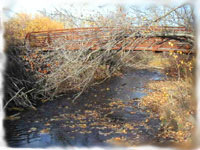|
Stream Crossings: Trails… from a River’s Point of View
“I hear footsteps….”
There’s more to me than you might know...
- I am a river.

- I am dynamic, ever-changing.
- I am pleasing to the eye and to the ear.
- I cut through the earth.
- I meander across the landscape.
- I carry water, sediment, and debris.
- I adjust my shape to maintain balance among runoff, sediment, and slope.
- I provide critical habitat for unique and diverse communities of aquatic and terrestrial organisms.
- I am home to many species of fish, mollusks, insects, amphibians, mammals, reptiles, and birds.
- I provide transport routes to their areas of food, shelter, reproduction, and colonization.
- I change and evolve over time in predictable patterns.
- I tend toward stability unless disturbed.

 |
|
Trails can harm me, or be my welcome companions;
poorly designed, constructed, or maintained trail crossings can: |
- Deliver polluted runoff and sediment to my channel.
- Divert, capture, or block my flow.
- Cause my channel to become unstable and disrupt transport of water, sediment, and debris.
- Impede or bar passage of fish, macroinvertebrates, and other aquatic organisms.
- Fragment habitat by creating impassable water depths, flow velocities, or jump heights.
- Impair or prevent access to food resources, refuge from unfavorable conditions, reproductive success, and new areas for colonization.
- Diminish biological diversity and species abundance.
I prefer solitude 
- It’s best to keep your distance – avoid interacting with me; trails can be too close for comfort.
- Travel parallel to my course, rather than perpendicular to it.
- Select a path that’s higher, flatter, and drier.
- Leave a healthy fringe of vegetation -- riparian buffer -- between me and a trail.

But, if you must come near or cross me…
- Minimize the number of crossings.

- Cross where my channel is most stable – at a riffle or where my banks are solid rock.
- Use a bridge instead of a ford or culvert.
- Span as much of my active floodplain as possible, preferably at least twice my bankfull width.
- Use an armored ford instead of a culvert.
- If you must use a ford or culvert – minimize the width of the ford or length of the culvert.
- Mimic nature – don’t change width, depth, or gradient.
|
|
- For culverts, use a natural bottom – don’t change the substrate.
- For fords, armor the crossing if the natural substrate consists of clay, silt, sand, or gravel. Use stones large enough to withstand scour during flood events.
|
- Size culverts to handle the largest expected flows and to allow a flood fringe to develop inside.
- Design the approach, to descend into and climb out of the crossing, at an 8% grade maximum.
- Provide grade reversals on both approaches to prevent water and sediment from entering the stream.

- Get runoff from the trail into the soil – use outslopes, dips, and waterbars. Avoid outside berms.
- Plan and design for possible failure of the crossing.
- Integrate other restoration activities into the design and construction of new or rebuilt crossings.

If you can do all this, we can peacefully coexist, but, there will be times when I will flood you...it’s natural!
Click to learn more about stream crossings.
Click to download a printable (pdf) version of this page.
You can read the preceding document
online or download to your hard drive. To open these files,
you must have Adobe
Acrobat Reader. Click here
to download for free. |


